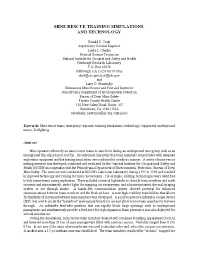Mining Publication: Mine Rescue Training Simulations and Technology
Original creation date: May 1998
Mine operators often rely on mine rescue teams to save lives during an underground emergency such as an underground fire, explosion or roof fall. It is extremely important that team members are provided with adequate exploration equipment and that training simulations are conducted in a realistic manner. A series of mine rescue training exercises was developed, conducted and evaluated by the National Institute for Occupational Safety and Health (NIOSH) in cooperation with the Pennsylvania Department of Environmental Protection, Bureau of Deep Mine Safety. The exercises were conducted at NIOSH's Lake Lynn Laboratory during 1995-1998 and resulted in improved technology and training for mine rescue teams. For example, existing technologies were identified to help rescue teams during exploration. These included chemical lightsticks to identify team members and mark crosscuts and mine materials, strobe lights for mapping out escapeways, and a helmet mounted thermal imaging system to see through smoke. A hands-free communication system showed potential for enhanced communications between team members and the fresh air base. A new high-visibility team lifeline that allows for flexibility of movement between team members was developed. A positive-pressure inflatable escape device (IED) was used to isolate the "hazardous" environment from fresh air and allow rescue team members to traverse through. An inflatable feed- tube partition that can rapidly block large openings such as underground passageways and simultaneously provide a feed-tube for high-expansion foam generators was also deployed for several simulations. During the simulations, mine rescue team members donned self-contained breathing apparatuses (SCBA) and traversed more than 305-m of mine passageways filled with nontoxic smoke. Visibility ranged from 0.3 to 0.9-m. In one area of the mine, a kerosene heater was used to simulate a fire and reduce the oxygen concentration. In another area, a 1.5 pct methane zone was established. The team members searched for "victims," mapped the passageways, built temporary stoppings and ventilated the smoke-filled entries. The teams indicated that the simulations were challenging and very informative.
Authors: RS Conti, LL Chasko, LD Stowinsky
Conference Paper - May 1998
NIOSHTIC2 Number: 20000099
Disaster and Emergency Management: International Challenges for the Next Decade, 1998 May; :453-464
See Also
- A Global Inventory of Mine Rescue Training Facilities: Compendium of Ideas to Improve U.S. Coal Mine Rescue Training
- Mine Rescue and Response
- Mine Rescue Training Facility Inventory - Compendium of Ideas to Improve US Coal Mine Rescue Training
- Mobile Adaptable RF/IT Infrastructure - Experimental (MATRIX)
- New Vest Style Escape SCSR Through SCSR Efficiency Improvement Study
- Refuge Alternatives in Underground Coal Mines
- Refuge Chamber Deployment and Occupancy Status During Mine Emergency Situations
- Rescue Technologies and Training
- Sprinkler Head Emergency Communications
- System Reliability and Environmental Survivability
- Page last reviewed: 9/21/2012
- Page last updated: 9/21/2012
- Content source: National Institute for Occupational Safety and Health, Mining Program


 ShareCompartir
ShareCompartir
